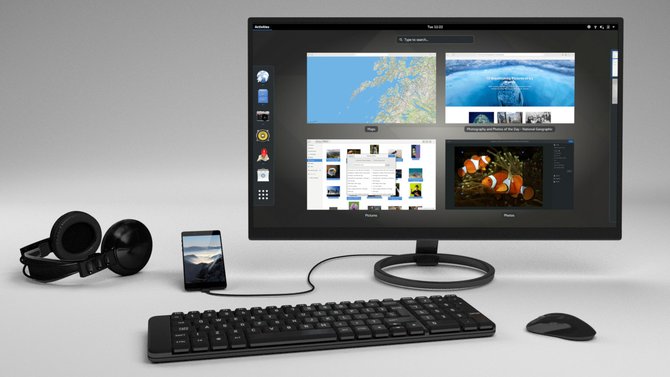Investing in Real Convergence
Like “privacy” and “security” the word “convergence” has become a popular term these days. When words like these become popular, companies tend to redefine them to match whatever they happen to sell. For instance when Google says they protect your privacy they mean “from everyone but us.” When Apple says they are secure, they mean “as long as you give us full trust and total control.”
When most people think of the promise of convergence they think of what I’ll refer to as “real convergence”–the idea of a single, portable computer that has your data and applications and that can be a desktop computer, a laptop or a pocket computer. To summarize: real convergence means taking your desktop computer with you in your pocket wherever you go. Fake convergence is the opposite: stretching a phone to fit on a larger screen.
The Folly of Fake Convergence

Convergence isn’t a new idea. Almost a decade ago I connected a Motorola Droid 4 to an Atrix laptop dock and the screen changed to Android tablet mode: apps were stretched and a little dock appeared along the bottom of the screen. I even wrote an article in Linux Journal about how I hacked together a Linux desktop over VNC that ran in a VM on the Android phone complete with a green-on-black terminal and dark hacker theme:

I actually bought my Atrix dock on a closeout sale because it was discontinued due to lack of demand. After awhile I stopped using the VM (it would never be usable in phone mode), fell back to the normal Android tablet mode (so I could easily access data when docked or not), and eventually stopped using the laptop dock altogether. Why did I and everyone else abandon this solution? Because it was fake convergence disguised as real convergence.
For the last decade we have had phones that can connect to a display and show a larger version of the phone screen. Sometimes the applications can even take advantage of the larger screen, although in many cases “tablet mode” just means doubling the phone UI to fill up the screen. Fake convergence doesn’t live up to the promise. It doesn’t solve the problem convergence was supposed to solve because it approaches it backwards. As a result we are all left unsatisfied having never realized the dream of a desktop in our pocket. Instead we have a phone connected to a monitor.
What Real Convergence Looks Like
Real convergence means bringing your desktop computer with you wherever you go. When we talk about how we have invested in convergence at Purism with PureOS we start with the desktop OS and shrink it down to your pocket.
PureOS on the Librem 5 is the same OS we use on our other products with the same applications as our desktop–just with a special kernel, shell, compositor, and a small set of other tools needed to run the OS on the phone hardware. Firefox isn’t some custom mobile fork, it’s just desktop Firefox. If you want to know more, this post does a good job of explaining the unique pieces in PureOS on the Librem 5 and how all these pieces fit together.
Avoiding Fragmentation
Fake convergence promises on other platforms has led to a common misconception that PureOS on the Librem 5 is yet another custom “mobile Linux OS” to add to the list of fragmented platforms developers have to port applications to. Developers who are already in the mobile ecosystem and used to fragmentation often ask us: “How do I port my Linux desktop application to the Librem 5?” The answer is “You don’t have to.” Instead, just make sure your desktop application works when resized to the phone’s screen resolution. No need to maintain a separate “mobile only” version of your code.
We want the whole Linux desktop ecosystem to be convergent, and so much of the investment Librem 5 backers have put into Purism has gone directly into innovations that bring convergence to the Linux desktop. We developed libhandy so that Linux application developers would have a common set of GTK libraries they can use to make their own desktop applications adaptive. We developed phosh and phoc so that applications would have a lightweight desktop shell and compositor that adapts to a phone screen. If you are familiar with the Linux mobile ecosystem, you have already seen the huge impact and wide adoption these tools now find in our community.
How Many Apps?
We often get asked “How many apps does the Librem 5 have?” One way of answering the question is how we answered it last year with an Application Compatibility Chart–a list of desktop applications that are either already adaptive, or otherwise fit on the Librem 5 screen.
Yet that answer is also misleading. Because we are focusing on real convergence, the actual answer is that we have thousands of applications on the Librem 5, today, many of them simply don’t yet fit on the small screen. Even the applications that don’t yet fit run fine when you either scale the screen or connect to a monitor.
Investing in Real Convergence

At Purism we believe real convergence is the future of personal computing: a single, portable computer that has your data and applications and that can be a desktop computer, a laptop or a pocket computer. We have invested in this future heavily and the Librem 5 is the realization of the convergence promise so many others have failed to keep. If you believe in real convergence, invest in the future you want to see. Help us continue to advance adaptive applications to bring desktop Linux to your pocket.
Discover the Librem 5
Purism believes building the Librem 5 is just one step on the road to launching a digital rights movement, where we—the-people stand up for our digital rights, where we place the control of your data and your family’s data back where it belongs: in your own hands.

Recent Posts
- Google to Pay Texas $1.4 Billion to End Privacy Cases
- Trump T1 Phone Android OS vs. PureOS
- After a week, Trump Mobile drops claim that the T1 Phone is “Made in the USA”
- The 2025 Most Secure Phone in The World Reviews Are In: Efani, Analytics Insight, Navi, and Cashify
- Why Purism Manufactures Electronics in the USA
Related Content
- Google to Pay Texas $1.4 Billion to End Privacy Cases
- The 2025 Most Secure Phone in The World Reviews Are In: Efani, Analytics Insight, Navi, and Cashify
- America’s Mobile Security Crisis: Why It’s Time for a Secure, Private Alternative
- Google Restricts Android Sideloading—What It Means for User Autonomy and the Future of Mobile Freedom
- How Big Tech Exploits Apps to Circumvent Privacy Laws & a Solution from Purism


